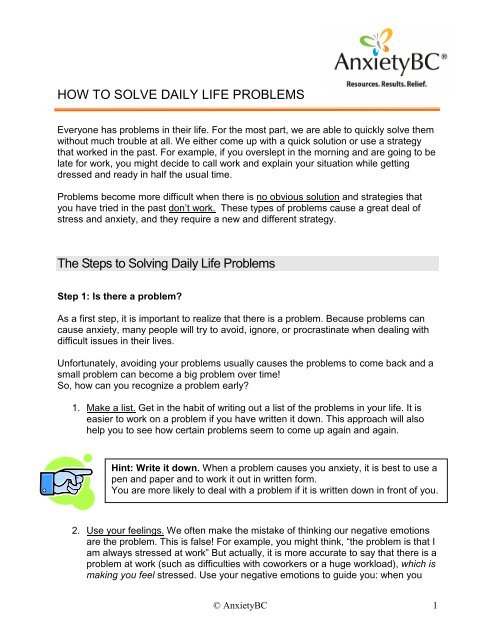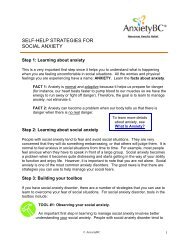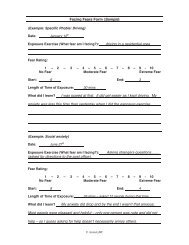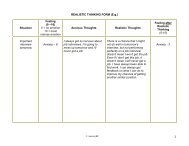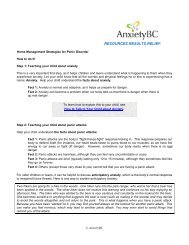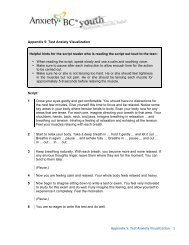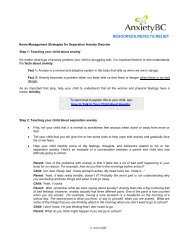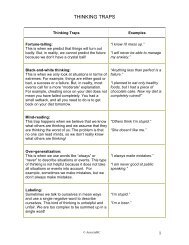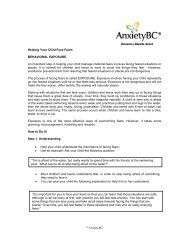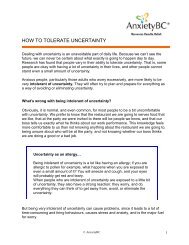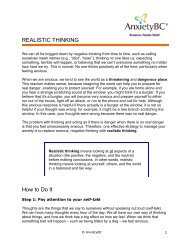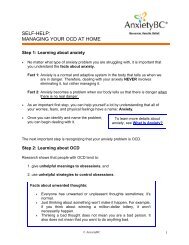How to Solve Daily Life Problems - AnxietyBC
How to Solve Daily Life Problems - AnxietyBC
How to Solve Daily Life Problems - AnxietyBC
You also want an ePaper? Increase the reach of your titles
YUMPU automatically turns print PDFs into web optimized ePapers that Google loves.
HOW TO SOLVE DAILY LIFE PROBLEMS<br />
Everyone has problems in their life. For the most part, we are able <strong>to</strong> quickly solve them<br />
without much trouble at all. We either come up with a quick solution or use a strategy<br />
that worked in the past. For example, if you overslept in the morning and are going <strong>to</strong> be<br />
late for work, you might decide <strong>to</strong> call work and explain your situation while getting<br />
dressed and ready in half the usual time.<br />
<strong>Problems</strong> become more difficult when there is no obvious solution and strategies that<br />
you have tried in the past don’t work. These types of problems cause a great deal of<br />
stress and anxiety, and they require a new and different strategy.<br />
The Steps <strong>to</strong> Solving <strong>Daily</strong> <strong>Life</strong> <strong>Problems</strong><br />
Step 1: Is there a problem<br />
As a first step, it is important <strong>to</strong> realize that there is a problem. Because problems can<br />
cause anxiety, many people will try <strong>to</strong> avoid, ignore, or procrastinate when dealing with<br />
difficult issues in their lives.<br />
Unfortunately, avoiding your problems usually causes the problems <strong>to</strong> come back and a<br />
small problem can become a big problem over time!<br />
So, how can you recognize a problem early<br />
1. Make a list. Get in the habit of writing out a list of the problems in your life. It is<br />
easier <strong>to</strong> work on a problem if you have written it down. This approach will also<br />
help you <strong>to</strong> see how certain problems seem <strong>to</strong> come up again and again.<br />
Hint: Write it down. When a problem causes you anxiety, it is best <strong>to</strong> use a<br />
pen and paper and <strong>to</strong> work it out in written form.<br />
You are more likely <strong>to</strong> deal with a problem if it is written down in front of you.<br />
2. Use your feelings. We often make the mistake of thinking our negative emotions<br />
are the problem. This is false! For example, you might think, “the problem is that I<br />
am always stressed at work” But actually, it is more accurate <strong>to</strong> say that there is a<br />
problem at work (such as difficulties with coworkers or a huge workload), which is<br />
making you feel stressed. Use your negative emotions <strong>to</strong> guide you: when you<br />
© <strong>AnxietyBC</strong> 1
are feeling anxious, stressed, frustrated, or annoyed in a particular situation, try <strong>to</strong><br />
find the problem that is making you feel that way.<br />
3. Find the challenge. A huge obstacle for most people is the negative way that they<br />
look at problems: if you think that problems are completely threatening, or that<br />
having them is a sign of weakness or failure, and you see yourself as a bad<br />
problem solver, you won’t solve the problem! That is, even if you are good at<br />
solving problems, you won’t try <strong>to</strong> deal with them if you don’t think you can and<br />
you don’t see any benefit <strong>to</strong> it.<br />
But if you can find some benefit or opportunity in a problem, you are more likely<br />
<strong>to</strong> work on it. For example, if your problem is not getting along with coworkers, the<br />
opportunity might be that it is a chance <strong>to</strong> improve your communication skills and<br />
possibly resolve some arguments with your coworkers.<br />
Key Point: There is always a benefit <strong>to</strong> solving problems.<br />
Remember that if you solve a problem, even a difficult one, it is one less<br />
thing <strong>to</strong> worry about, and one less problem on your problem list!<br />
Step 2: What is the Problem<br />
Before trying <strong>to</strong> solve a problem, you first need <strong>to</strong> define it. Here are some tips on how<br />
<strong>to</strong> properly define what your problem is:<br />
• Focus on the problem itself. Ask yourself the following questions:<br />
o What is the situation (e.g., my boss gives me <strong>to</strong>o much work).<br />
o What would I like the situation <strong>to</strong> be (e.g., I would like my boss <strong>to</strong> give me<br />
less work).<br />
o What is the obstacle that is keeping me from my desired situation (e.g.,<br />
I’m unsure how <strong>to</strong> talk <strong>to</strong> my boss about my work obligations).<br />
You can then put your problem in<strong>to</strong> a sentence. For example, the problem is that<br />
my boss gives me <strong>to</strong>o much work; I would like <strong>to</strong> have less work, but I’m not sure<br />
how <strong>to</strong> ask him <strong>to</strong> reduce my workload.<br />
• Just the facts! Be careful <strong>to</strong> avoid putting opinions or assumptions in<strong>to</strong> your<br />
definition. For example, thinking that your work problem is that “my boss is a jerk”<br />
is an opinion. Besides, it makes the problem almost impossible <strong>to</strong> solve.<br />
© <strong>AnxietyBC</strong> 2
• Be specific and concrete. If you are <strong>to</strong>o vague when defining your problem, it will<br />
be difficult <strong>to</strong> know how <strong>to</strong> even begin solving it. For example, thinking that, “my<br />
problem is my work” is not specific or concrete; what is it about your work that is a<br />
problem <strong>How</strong> will you even start fixing this kind of problem<br />
Step 3: What are my Goals for this Problem<br />
In order <strong>to</strong> know whether you have solved your problems, it is important <strong>to</strong> know ahead<br />
of time what a solved problem would look like. Here are some tips for setting goals:<br />
• Be realistic. Make sure that your goals are achievable; if they are <strong>to</strong>o unrealistic,<br />
you will probably not reach them, and you will feel pretty bad. For example, with<br />
the work problem, if your goal is <strong>to</strong> only do your work when you feel like it, you will<br />
probably not solve your problem.<br />
• Be specific. If your goals are vague, you won’t know when you have reached<br />
them. For example, if you think, “my goal is <strong>to</strong> be happy at work”, what does that<br />
mean Do you want <strong>to</strong> be happy all the time <strong>How</strong> happy When will you know<br />
when you have reached your “happy” goal<br />
• Start with short-term goals. If you set goals that can be reached relatively quickly,<br />
you are more likely <strong>to</strong> work on your problem. You can set long-term goals <strong>to</strong>o, but<br />
make sure <strong>to</strong> have short-terms goals as well so that you know whether the<br />
problem is solved. With the work problem, a long-term goal might be <strong>to</strong> get<br />
another job, but a short-term goal might be <strong>to</strong> reduce your workload.<br />
Step 4: Thinking up Solutions<br />
The biggest mistake that we tend <strong>to</strong> make when thinking up solutions for our problems is<br />
<strong>to</strong> think about the same old solutions. But if those old solutions worked, the problem<br />
would not still be around. In order <strong>to</strong> come up with new solutions, you can follow the<br />
rules of brains<strong>to</strong>rming:<br />
1. Devise lots of solutions. You are more likely <strong>to</strong> come up with a good solution if<br />
you have a lot of solutions <strong>to</strong> choose from. Try <strong>to</strong> come up with at least 10<br />
possible solutions <strong>to</strong> your problem.<br />
2. Don’t judge your solutions. Remember that you aren’t choosing a solution yet,<br />
you are just trying <strong>to</strong> think of as many options as you can; so don’t judge them.<br />
Even silly, strange or extreme solutions are good ones at this stage. For the work<br />
problem, you might think about solutions like “quit my job” or “organize a strike”.<br />
Write them down! You will never come up with new solutions if you aren’t willing<br />
<strong>to</strong> even think about silly ones.<br />
© <strong>AnxietyBC</strong> 3
3. Have a variety of solutions. Make sure that your solutions are different from each<br />
other. For example, with the work problem, there is not much variety if your<br />
solutions are <strong>to</strong> “ask the boss <strong>to</strong> have lunch with me”, “ask the boss <strong>to</strong> have<br />
coffee with me”, or “ask the boss <strong>to</strong> come out <strong>to</strong> dinner”. Although these are three<br />
solutions, there is not much variety, because they are basically all the same<br />
solution: ask the boss <strong>to</strong> do something social with you.<br />
REMEMBER: When it comes <strong>to</strong> difficult problems, the first idea that<br />
comes <strong>to</strong> your mind is not always the best. Take the time <strong>to</strong> come up<br />
with new possibilities.<br />
Some other tips for thinking up lots of different solutions are:<br />
• Be specific. Make sure that your solutions involve specific behaviours, and not<br />
general strategies. For example, the solution, “give the boss a list of all the work I<br />
am doing now” is very specific, compared <strong>to</strong> the solution, “be more assertive with<br />
my boss”. If you picked the latter solution, you would have a new problem:<br />
figuring out how <strong>to</strong> be more assertive!<br />
• Ask for help. If you are having a hard time coming up with new and different<br />
solutions <strong>to</strong> your problem, ask friends, family, or coworkers for advice. Other<br />
people might have ideas that you have not even thought of.<br />
Step 5: Deciding on a Solution<br />
If you struggle with anxiety, actually picking a solution <strong>to</strong> your problem can often seem<br />
quite difficult. <strong>How</strong>ever, it is important <strong>to</strong> remember that not solving a problem can lead<br />
<strong>to</strong> more anxiety than trying <strong>to</strong> solve it, no matter how anxious you feel. The following are<br />
some guidelines that can help you find the best solution <strong>to</strong> your problem.<br />
REMEMBER: The goal is <strong>to</strong> find the best solution <strong>to</strong> your problem, NOT<br />
the perfect solution. If there was a “perfect” solution, you would have<br />
already found it!<br />
1. Will this solution fix my problem and help me reach my goals<br />
This guideline might seem obvious, however, it is important <strong>to</strong> make sure that your<br />
solution will help you reach your goals. For example, “work harder” as a solution <strong>to</strong><br />
the work problem will not help you reach your goal of having less work <strong>to</strong> do in a day.<br />
© <strong>AnxietyBC</strong> 4
2. <strong>How</strong> much time and effort does this solution involve<br />
You can expect that any solution will require some time and effort, but the amount<br />
involved needs <strong>to</strong> be related <strong>to</strong> your needs. “Quitting my job” as a solution <strong>to</strong> the<br />
work problem might involve a great deal of effort, since you would have <strong>to</strong> start<br />
looking for a new job.<br />
3. <strong>How</strong> will I feel if I pick this solution<br />
If you think that a solution will make you feel bad, guilty, or <strong>to</strong>o anxious, it might not<br />
be the best solution. For example, “lie <strong>to</strong> the boss about how much work I actually<br />
did” might make you feel bad.<br />
4. What are the costs and benefits of this solution <strong>to</strong> myself and others right now and<br />
in the long-term<br />
The best solution will have the most benefits, and the fewest costs possible. But<br />
when thinking about costs and benefits you want <strong>to</strong> think about how a solution will<br />
affect:<br />
You right now and in the future<br />
Other people in your life right now and in the future<br />
For example, if you picked the solution, “blame my coworkers for work that isn’t<br />
done”, this might solve your problem right now, but it will probably seriously affect<br />
your relationship with your coworkers, and in the long-run your boss will probably find<br />
out. The costs of this solution seem <strong>to</strong> outweigh the benefits.<br />
REMEMBER: There is no perfect solution, so when you are judging each<br />
potential solution, it is unlikely that it will meet all four criteria. That is, it<br />
probably won’t solve the problem with no time or effort, make you feel<br />
happy while doing it, and have no costs and only benefits. You are looking<br />
for a solution that BEST meets the criteria, not perfectly.<br />
STEP 5: Carrying Out the Solution<br />
This is often the most difficult step because you now have <strong>to</strong> actually start carrying out<br />
the solution you chose. Most people are afraid that they might have picked the wrong<br />
solution, or that perhaps there is a better solution if they just think about the problem<br />
more. This is not helpful thinking! It is better <strong>to</strong> act than <strong>to</strong> do nothing at all.<br />
To help you carry out your solution, you can make an action plan. If you know how you<br />
are going <strong>to</strong> carry out your solution, you are more likely <strong>to</strong> do it.<br />
© <strong>AnxietyBC</strong> 5
Your plan should include all the steps that you will need <strong>to</strong> take <strong>to</strong> carry out the solution,<br />
and it should be as specific and concrete as possible. For example, if my solution is <strong>to</strong><br />
“get a new job”, some of the steps involved in that solution might be:<br />
- make a list of the types of jobs I would like <strong>to</strong> have<br />
- buy a newspaper every day and check the “help wanted” ads<br />
- contact all the employers who advertise a job that I would like <strong>to</strong> have<br />
- rearrange my work schedule so that I can go <strong>to</strong> interviews if necessary<br />
STEP 6: Checking In on Your Problem<br />
Now that you have carried out your solution, you need <strong>to</strong> make sure that it is working.<br />
Sometimes the best-laid plans don’t always turn out perfectly, so it is a good idea <strong>to</strong><br />
have markers that let you know whether you are on the right track. For example, with<br />
the work problem, you might use your workload as a marker for tracking your solution. If<br />
you notice that your workload is going down, then your solution is probably working.<br />
What do I do if my solution isn’t working<br />
Because the unexpected happens in life, sometimes even the best solutions don’t work<br />
out well, which is unfortunate, but normal. The best thing <strong>to</strong> do is <strong>to</strong> recycle through the<br />
different steps and ask yourself the following questions:<br />
o Did I define the problem properly<br />
o Were my goals realistic<br />
o Are there other possible solutions<br />
o Is there a better solution that I could have picked<br />
o Did I carry it out as planned<br />
If you work through these steps, you might find that you went wrong somewhere, and<br />
then you can fix it and try again!<br />
TIP: Solving the difficult problems in life is hard work, so make sure <strong>to</strong><br />
reward yourself afterward for a job well done.<br />
Here is a helpful resource for more information on problem solving:<br />
Solving <strong>Life</strong>’s <strong>Problems</strong>: A 5-Step Guide <strong>to</strong> Enhanced Well-Being by A.M. Nezu,<br />
C.M. Nezu, and T.J. D’Zurilla. Springer Publishing.<br />
© <strong>AnxietyBC</strong> 6


